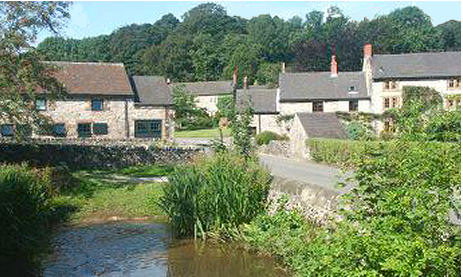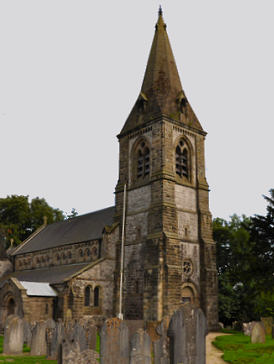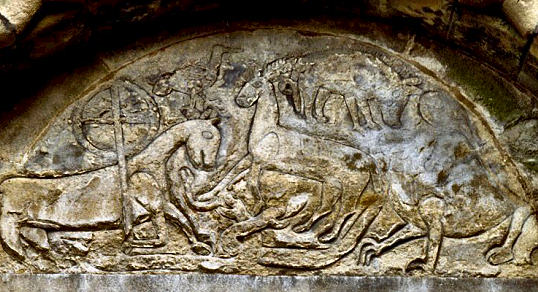Parwich
OS Grid ref:-
 The pleasant village of Parwich is situated 7 miles to the north of the town of Ashbourne on the southern edge of the Peak District National Park, it is dramatically set among huge limestone outcrops, which rise to over 1000 feet.
The pleasant village of Parwich is situated 7 miles to the north of the town of Ashbourne on the southern edge of the Peak District National Park, it is dramatically set among huge limestone outcrops, which rise to over 1000 feet.
Parwich is an ancient village, there is evidence to suggest that it was once a Celtic settlement. The name derives from both the Celtic and Saxon languages. 'Par,' is thought to come from the Celtic name for the brook flowing through the village and the second part, 'Wich,' from the Saxon word for a dairy farm.
The village is referred to in the Domesday Book of 1086 as "Pevrewic" under Derbyshire in the lands belonging to the King. The book records:-
 "In Parwich are 2 carucates of land to the geld. There is land for two ploughs. It is waste. Kolli holds it of the king and he has three villans with two bordars with three ploughs. There are twelve acres of meadow. To this manor belong berewicks of Alsop-en-le-Dale, Hanson Grange and Cold Eaton. There are 2 carucates of land to the geld. There is land for two ploughs. It is waste."
"In Parwich are 2 carucates of land to the geld. There is land for two ploughs. It is waste. Kolli holds it of the king and he has three villans with two bordars with three ploughs. There are twelve acres of meadow. To this manor belong berewicks of Alsop-en-le-Dale, Hanson Grange and Cold Eaton. There are 2 carucates of land to the geld. There is land for two ploughs. It is waste."
Parwich was part of the ancient Crown lands and after the Conquest was granted to the Ferrers, Earls of Derby. Robert de Ferrers took a prominent part in the Montfort Rebellion against the crown , and his lands were siezed by King Edward I, who gave the manor to his brother Edmund Crouchback, Earl of Lancaster, it then became part of the Duchy of Lancaster held by the Cokayne family of Ashbourne Hall.
 In 1603 the Parwich estate was sold to Thomas Levinge and remained in the Levinge family, who built Parwich Hall in 1747. In 1814 the estate was purchased by William Evans, a Derbyshire M.P. Sir Thomas William Evans, his son built the present village school and St Peter's church in 1874. After 1892, and the estate was split between the Carrs and the Gisbornes. After World War One, the estate was sold to the Inglefields who sold it in the 1970s.
In 1603 the Parwich estate was sold to Thomas Levinge and remained in the Levinge family, who built Parwich Hall in 1747. In 1814 the estate was purchased by William Evans, a Derbyshire M.P. Sir Thomas William Evans, his son built the present village school and St Peter's church in 1874. After 1892, and the estate was split between the Carrs and the Gisbornes. After World War One, the estate was sold to the Inglefields who sold it in the 1970s.
The village is consists of mainly limestone houses, set around the pleasant village green and pond. It contains a number of fine seventeenth and eighteenth century houses, the most notible probally being the eigtheenth century Parwich Hall situated above the village.
St. Peter's Church stands at the centre of the village. Elements of the rebuilt church (pictured right) date back to Norman times. It retains the original Norman doorway and chancel arch including a fine Saxon tympanum (above left) over the west doorway. The tympanum depicts the lamb of God with a cross, a stag trampling on a serpent, a wolf and a pig.
Nearby places of interest
The Burrows Garden is situated 5 miles to the south east of Ashbourne. Set in beautiful countryside, the superb gardens cover 5 acres.
Dovedale, a dramatic limestone ravine, with its impressive rock outcrops and tranquil woodlands is arguably the prettiest of the dales in the Peak District National Park and is owned by the National Trust.
The Manifold Valley, which runs almost parallel with Dovedale, has been described as the 'Switzerland of Staffordshire' and offers some of the most spectacular scenery in the Peak District National Park.
Biddulph Grange, one of Britain's most exciting and unusual gardens, was created by the horticulturalist James Bateman (1811–1897), for his large collection of plants from around the world.
Haddon Hall near Bakewell, is an architectural gem. Dating back to the eleventh century, the hall has been described as "the most complete and most interesting house of [its] period", it is the finest example of a medieval manor house currently in existence in England.
